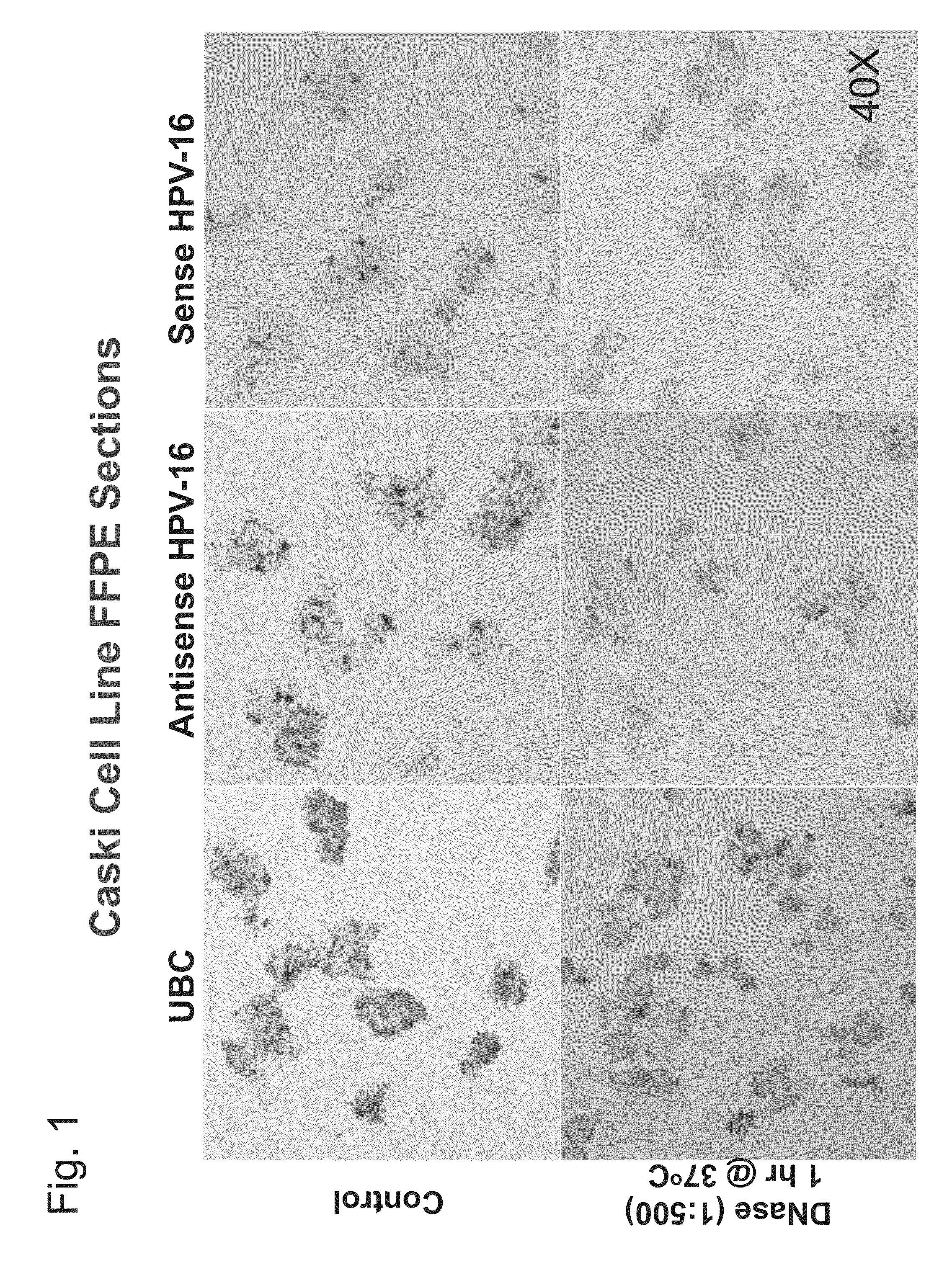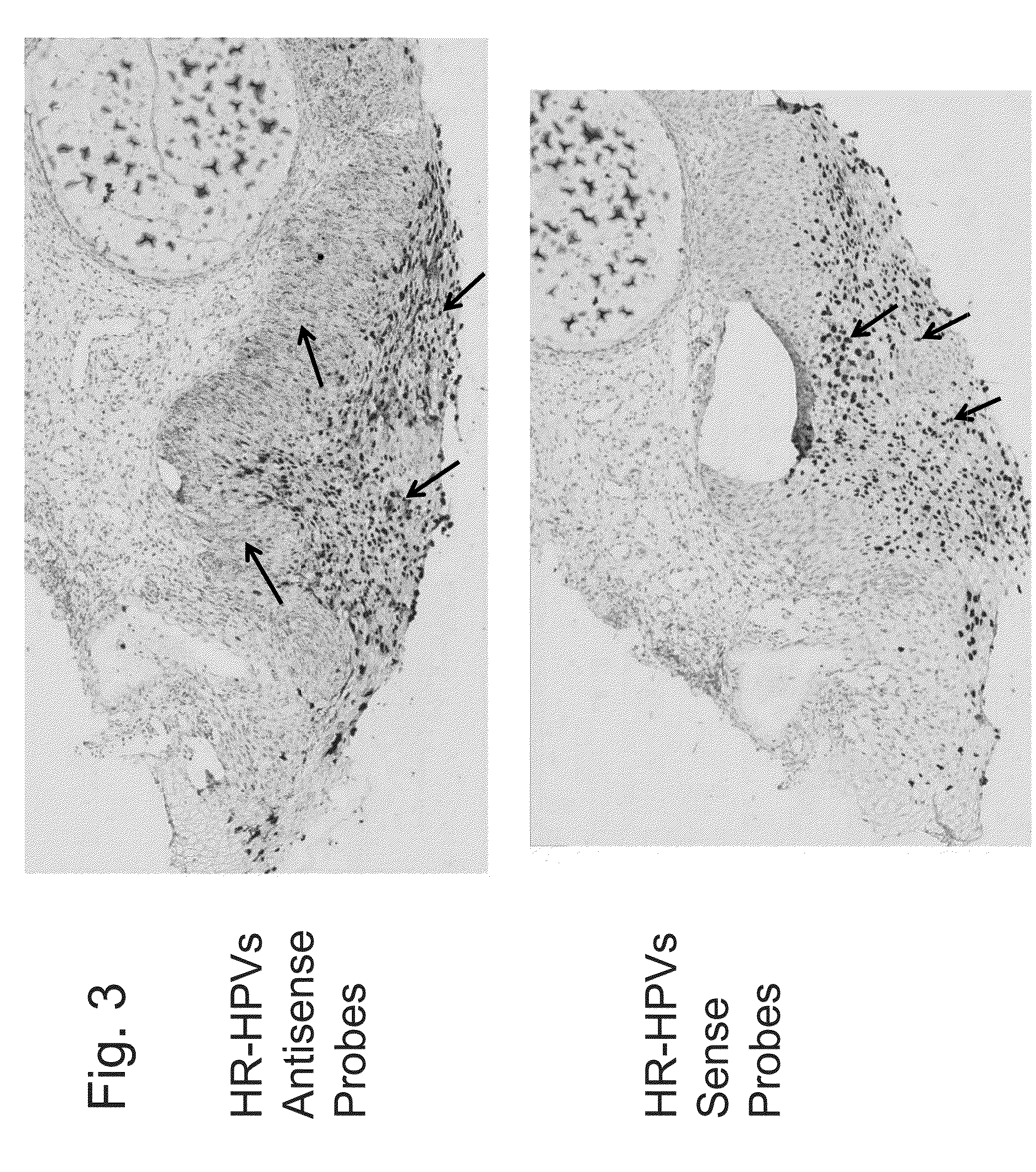Differentiation between transient and persistent high-risk HPV infection by in situ hybridization
a high-risk, transient technology, applied in the field of in situ hybridization assays and cervical sample analysis, can solve the problems of poor clinical specificity, unnecessary follow-up procedures, and insufficient hpv infection alone for oncogenic transformation
- Summary
- Abstract
- Description
- Claims
- Application Information
AI Technical Summary
Benefits of technology
Problems solved by technology
Method used
Image
Examples
example i
HPV Detection in Caski Cells
[0134]This example describes detection of HPV nucleic acids in Caski cells.
[0135]An RNA in situ hybridization (ISH) assay was developed based on RNAscope® technology (Advanced Cell Diagnostics) to detect the mRNA of E6 and E7 oncogenes of HR-HPVs (Bishop et al., Am. J. Surg. Pathol. 36:1874-1882 (2012); Schache et al., Br. J. Cancer 108:1332-1339 (2013); Ukpo et al., Am. J. Surg. Pathol. 35:1343-1350 (2011); Wang et al., J. Mol. Diagn. 14:22-29 (2012)). In the assay, frequent nuclear staining nuclear staining was observed, which may be DNA in origin, in HPV-infected cells. To investigate this, RNAscope® ISH assays were performed on the cervical cancer cell line Caski known to harbor HPV 16 using probes targeting the E6 and E7 genes. Two types of probes were used: a standard antisense probe complementary to E6 and E7 mRNA, and a sense probe targeting the same regions but in the same sense as the E6 / E7 mRNA (probe sets commercially available from Advanced C...
example ii
HPV Detection in Cervical Tissue Samples
[0139]This example describes detection of HPV nucleic acids in cervical tissue samples.
[0140]High-risk HPV E6 / E7 mRNA is known to be up-regulated in high grade CIN lesions (CIN2+) but not in low grade lesions (CIN1)(Lie and Kristensen, Expert Rev. Mol. Diagn. 8:405-415 (2008)). An in situ hybridization assay was performed essentially as described in Example I on cervical tissue samples. Briefly, 5 micron thickness slide-mounted sections were de-paraffinized through 100% xylene and ethanol washes. Tissues were then treated serially with commercially available buffers (Advanced Cell Diagnostics): Pre-Treatment 1 solution (endogenous hydrogen peroxidase block with Pretreat 1 solution for 10 minutes at room temperature); Pre-Treatment 2 (100° C., 15 minutes immersion in Pretreat 2 solution); and, Pre-Treatment 3 (protease digestion, 40° C. for 30 minutes); rinses with water were performed after each Pre-Treatment step. Tissues were then hybridized...
PUM
| Property | Measurement | Unit |
|---|---|---|
| temperature | aaaaa | aaaaa |
| Tm | aaaaa | aaaaa |
| Tm | aaaaa | aaaaa |
Abstract
Description
Claims
Application Information
 Login to View More
Login to View More - R&D
- Intellectual Property
- Life Sciences
- Materials
- Tech Scout
- Unparalleled Data Quality
- Higher Quality Content
- 60% Fewer Hallucinations
Browse by: Latest US Patents, China's latest patents, Technical Efficacy Thesaurus, Application Domain, Technology Topic, Popular Technical Reports.
© 2025 PatSnap. All rights reserved.Legal|Privacy policy|Modern Slavery Act Transparency Statement|Sitemap|About US| Contact US: help@patsnap.com



